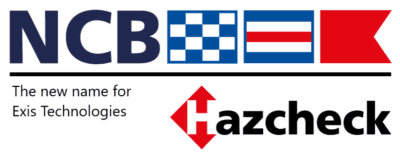Containers: Tools for the job – Hazardous Cargo Bulletin
Exis Technologies’ James Douglas explains how new systems are being developed in an aim to reduce the risks of fires aboard container vessels
In April last year, Exis Technologies became the software division of the National Cargo Bureau (NCB), a New York-based not-for-profit organisation entrusted with ensuring safety of life and cargo at sea. Exis Technologies and NCB have since been working on several new initiatives to help improve safety in the supply chain.
ICHCA International, the cargo handling operative’s association, has calculated that of the 60 million packed containers moved each year, 10 per cent are declared as dangerous goods with some ships carrying more than 1,000 containers with dangerous goods on any given voyage. Shipping lines are therefore keen to ensure that dangerous goods are properly classified, packaged, packed and declared throughout the supply chain. Most of the significant ship fires are attributed to incorrectly declared dangerous goods, often exacerbated by criminal non-declaration or fraud.
Complex critical checks must be carried out for all dangerous goods consignments:
- Most lines restrict or prohibit certain classes of dangerous goods (particularly explosives, radioactive materials and some organic peroxides in reefer containers), so the booking line needs to know if a partner line will accept them.
- Detailed stowage requirements (such as on-deck only, away from accommodation, or away from sources of heat) imply limited suitable space.
- Many ports and individual container terminals have strict rules on the classes of dangerous goods that can be loaded, unloaded or transhipped, or even present on board while the ship is in port. The ‘wrong’ dangerous goods aboard a ship can cause disruption.
Of course, these checks rely on the shipper properly declaring the cargo as dangerous goods in the first place. However, mistakes can be made due to lack of competence or, unfortunately in some cases, by deliberately incorrectly declaring cargo to save cost or time. In other cases, the cargo may have been properly declared, but mistakes are made with packing and stowing the cargo in the container.
CHECK THE CARGO
TT Club, which estimates that a container ship fire at sea occurs on average every 60 days, is keen to highlight these problems with its recently launched ‘Cargo Integrity’ campaign (HCB April 2019, page 54). All types of cargo can be mishandled but wrongly classified, packed or simply inaccurately identified dangerous goods commodities bring the greatest potential risk of disaster. These perilous incidents not only frequently cost lives, millions of dollars in cargo losses and ship damage, but also significant delays in cargo supply chains amounting to major disruption across numerous industries.
Unless the container is physically opened and inspected, there is no way of knowing for sure whether the cargo is safe for transport. The diagram below shows the current landscape regarding the shipment of dangerous goods by sea.
If the cargo is properly declared as dangerous goods, shipping lines can use tools such as Exis Technologies’ Hazcheck to verify that the declared cargo complies with the International Maritime Dangerous Goods (IMDG) Code and other local rules and restrictions. More than 400,000 validations are made with Hazcheck per month for the top 10 lines, representing 70 per cent of the world’s dangerous goods container traffic. Around 4,000 rejections are picked up each month with the software.
Exis Technologies launched the Hazcheck Restrictions Portal to reduce incidents at sea, primarily by ironing out confusion in the complex operational processes involved in navigating today’s supply chains with dangerous goods. Each carrier has been collating its own record of restrictions in relation to house policies, shipowner policies, ship constraints (for instance, the number of available reefer points), and restrictions applied at the applicable ports or terminals of loading, transit, transhipment and discharge.
Exis Technologies is cooperating with two of the leading industry insurance organisations, TT Club and the UK P&I Club, and has been working with container operators, ports and terminals to build a shared database of local and operator restrictions. Until now there has been no single source of data. Ports and terminals are being encouraged to upload their data free of charge over the next two years so it can be accessed by all parties, including shippers and forwarders.
LOOK IN THE BOX
TT Club’s records indicate that, across the intermodal spectrum as a whole, 66 per cent of incidents related to cargo damage can be attributed to poor practice in the overall packing process; that is not just in securing but also in cargo identification, declaration, documentation and effective data transfer.
Therefore, a final option is to physically inspect selected bookings and containers before they are loaded to verify that cargo is declared, packed and stowed correctly. Over the last 10 years, fewer than 80,000 containers have been inspected by the reporting competent authorities each year, with deficiencies found in about 10 per cent of cases on average, according to TT Club. NCB, for example, recorded a 9 per cent failure rate out of around 31,000 inspections in the last reported 12 months. Most of these inspections are of declared dangerous goods. The most frequent reasons for rejection are placarding/marking, followed by packing and stowage issues, leaks, documentation and improper segregation.
INSPECTION SOLUTION
Exis Technologies has been working with NCB to develop a new container cargo inspection system in line with customer requirements. Earlier this year Exis announced the launch of Hazcheck Inspections, a web-based database and access portal where inspection companies can plan and enter details of cargo inspections completed on behalf of container or vessel operators.
The solution allows the container or vessel operator to log in with secure access and view or download inspection results and/or analytics. Consistent data is recorded and reported regardless of where and who records the inspection result. Non-confidential analytics data can be shared with partners and third parties to help influence policy concerning shipment of dangerous goods by sea.
Operators can send cargo details to the inspection company and pre-entered planned data can be re-used when the inspections details are recorded. The benefits include a common database, consistent reporting and data analysis. Operators have the option to share non-confidential data with partners and third parties, such as the Cargo Incident Notification System (CINS).
In August last year, NCB began inspecting containers carrying imports to the US for CINS members to determine the extent of improperly declared or stowed cargo; 500 containers will be inspected in total and the findings will help identify trends. “The goal is to look at containers originating from countries where there are not a lot of container inspections,” says NCB president Ian Lennard. “It’s a way for the industry to figure out what we don’t know and hopefully it will lead to some knowledge and better ways of doing things.”
Port Supervisor also provided important input on pre-planning inspections before loading cargo. About 4,000 outbound containers (about 15 per cent of them with hazardous materials) were inspected last year, of which some 10 per cent were improperly placarded or labelled. Around 23 per cent were rejected because of problems with lashing or securing cargo.
With two major companies on board, the database has had a kickstart, but the next challenge is to encourage other companies to help build up a database of activity and dangerous goods declaration issues on a global scale.







